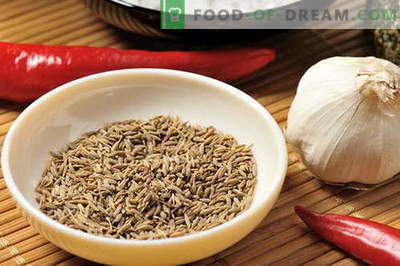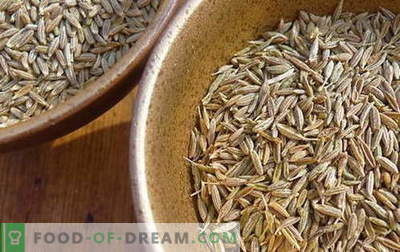
Each nation has its favorite condiments and spices. In Bulgaria, paprika is put in many dishes, for it is no wonder that sweet pepper is called Bulgarian pepper. Georgians love to season hops-suneli meat and vegetables. And in Asia, not a single pilaf is complete without jeera, a spicy plant resembling caraway in its appearance.
But in fact, cumin and cumin are different spices. And a man in the street who is not versed in plants can notice the difference only by trying seeds on a tooth.
After all, even in appearance, the seeds of these plants are almost the same - narrow seeds of a greenish-marsh color of half a centimeter long with prominent facets.
The taste of cumin resembles dill, but with a more pronounced spicy aroma, not bitter. The flavor of zira is a bit weaker, but its taste is pronounced, and at the same time you can feel a slight spicy burning sensation.
During the heat treatment of these spices, the following happens: a pinch of jeera, added to the dish during cooking, saturates it with a strong spicy aroma, which is not confused with the smell of any spice.
In order for the cumin to give its taste and smell to the dish, you need to put at least half of a teaspoon. And even more. But now we are talking about Zira, which means about the dishes to which it is added.
What kind of food is added to cheese
Despite such a peculiar pungent smell, it is very popular. It refines the taste of meat, especially lamb. Therefore, it is often added to the marinade for barbecue, given, of course, national traditions and taste preferences. Zira is popular in Afghanistan, Iran, India, as well as in Tajikistan and Uzbekistan. For example, when marinating kebabs in Tajik along with onions, they put jira seeds. And for Kokand-style kebabs (Uzbek cuisine), mutton kidneys and liver marinate with lamb. All these meat products are sprinkled with crushed Zira, black pepper and salt.
By the way, there is a second name for crushed powder of Zira - cumin, and this is confusing to many.
Cumin is added to meat dishes, especially when frying, as whole jira seeds burn and burn and acquire a sharp unpleasant taste.
As in the Tajik cuisine, and in the Uzbek meat for sausages, along with onions and garlic, put zira. In cooking horse sausage (Uzbek cuisine), zira is a must-have ingredient.
Zira is often added to rice dishes. It can be both spicy rice from Indian cuisine, and Uzbek Uzbek pilaf, which is prepared for a holiday.
Zira, along with dill, cumin and fennel, are put in marinades while canning tomatoes and cucumbers. It is also used in sauerkraut.
This spice is increasingly found in European dishes: dumplings, omelettes, soups.
Fermented milk products and cheeses are prepared in the Baltic countries with zira.
Zira in Indian Cuisine
A special place in Indian cuisine is zira.
It is part of the famous spicy mixture Garam Masala. Cardamom, coriander, cloves, pepper, cinnamon are added to it along with zira. These spices are lightly fried in a pan without oil, and then grind in a coffee grinder. This mixture is used to add savory flavor to pea and other legume soups, put into vegetable dishes, sauces, and used in baking cakes and muffins.
Zira (cumin) is a must-have ingredient in spicy curry mix. It may include up to thirty different herbs and seeds. The most famous of them - coriander, mustard, chili, fenugreek, nutmeg, mint.
They are the same as for garam masaly, fried first in a frying pan without oil, and then ground in a coffee grinder. Curry goes well with meat, fish, vegetable dishes, as well as rice.
What spices does Zura combine
- Zira harmonizes well with dill, onion, and fennel.
- You can put it in dishes with cumin and coriander.
- Cumin, along with cardamom, cloves, nutmeg and cinnamon, is added to dough products.
- Zira, saffron and barberry are the perfect combination for pilaf.
Useful Information
In addition to the pronounced taste of the zira has other advantages.
- It improves the appetite and contributes to better digestion of food.
- It helps get rid of stomach cramps and flatulence.
- Cinnamon decoction cures cough.
- Zira and honey, added to milk, relieve insomnia.
- This spice improves the functioning of the cardiovascular system and the brain.
Mistress to note
- There are several varieties of spirits. Most often on sale there is white zira (cumin). She has a slightly nutty flavor and a mild flavor. Before use, this spice is lightly fried or in oil or in a dry frying pan.
- Blackbird is less common. She has a sharp bitter taste and a strong spicy aroma. It is added to food immediately and in small quantities.
- Another type of black zeira, Bunium, is common in Tajikistan. It has a burning taste and is practically not used in food.
- Zira from bitter storage starts to taste bitter. Cumin oil is to blame for everything, which quickly deteriorates. Therefore, its future use is not harvested.
- Zira, like any spicy plant, can cause an allergic reaction, so its first use should be kept to a minimum in order to eliminate undesirable consequences.























